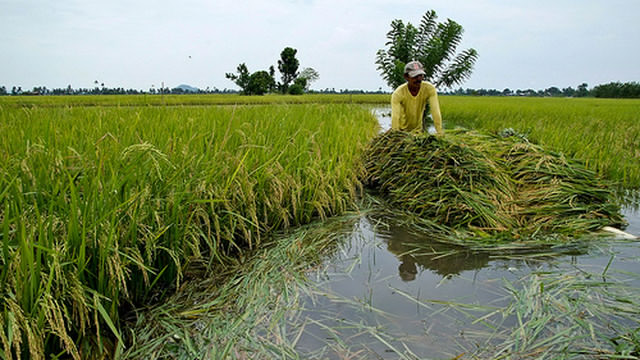SUMMARY
This is AI generated summarization, which may have errors. For context, always refer to the full article.

MANILA, Philippines – The Philippines may reach 98% rice self-sufficiency by the end of 2014, said Agriculture Secretary Proceso Alcala during his department’s budget hearing on Wednesday, August 13, in Batasan, Quezon City.
“We project that we will be 96-98% rice self-sufficient in 2014,” he told congressmen at the budget hearing.
But he told reporters that this projection does not consider typhoons that may again damage the agricultural sector this year.
The Philippines is currently 96% self-sufficient in rice. It did not meet its target of 100% self-sufficiency in 2013 because of damage caused by typhoons, notably Super Typhoon Yolanda (Haiyan), said Alcala.
Despite Yolanda, the country was able to achieve its highest yield of palay in history by the end of 2013 – 18.44 million metric tons. He said the improvement in local production of palay is unprecedented. In 2010, the country was only 82% sufficient.
But Representative Neri Colmenares of Bayan Muna asked why, despite the sterling figures from the DA, the country was still importing thousands of metric tons of rice from countries like Vietnam and Thailand. The country is still one of the top rice importers in the world.
“If we were 96% rice self-sufficient in 2013 but we imported 500,000 MT. In 2014, we can even go up to 98% self-sufficient but we are importing 1.3 million MT. How do we explain that to the people? The math does not add up,” said Colmenares.
The country continues to import because of the need to maintain buffer stock, which is used to stabilize prices in the market, replied Alcala.
“Our production is good but our cost of production is still high which means our rice is expensive on the commercial side. If we do not have low-priced rice with the National Food Authority (NFA) as buffer stock, the consumers will get angry because the price of rice will be high.”
The DA projects that demand for rice in 2014 will be 12.9 million MT. Farmers can produce as much as 12.38 million MT this year, making the gap between supply and demand only 500,000 MT. But according to the NFA, the country will import 1.3 million MT this year.
Is the PH agri sector competitive?
The only way to reduce importation is to help rice farmers lower their production cost so as to make the price of local rice more competitive with Vietnam and Thailand.
Thailand rice is being produced at a cost of P8.40 (US$0.19) per kilogram, while Vietnam rice is being produced at P5.40 ($0.12) per kilogram. In comparison, each kilogram of Philippine rice costs more than P10 ($0.23) to produce.
Raising competitiveness of local agricultural products is one of the priorities of the DA, said Alcala. In their proposed 2015 budget, funds to develop major agricultural products like rice, livestock, corn, high-value crops and fisheries increased.
The 2015 budget of the entire department increased by 1.81% from its 2014 budget to P51.7 billion ($1.175 billion).
| CROP | 2014 BUDGET (PHP) | 2015 PROPOSED BUDGET | % DIFFERENCE |
| Rice | 6,900,451 | 7,003,505 | 1% |
| Livestock | 1,350,444 | 1,525,545 | 13% |
| Corn | 1,796,965 | 2,296,519 | 28% |
| High Value Crops (vegetables, coffee) | 1,673,447 | 2,199,697 | 31% |
| Fisheries | 4,181,910 | 4,567,069 | 9% |
Funds will go mostly to putting up post-harvest facilities and helping farmers gain access to farm machines like rice threshers, combine harvesters and transplanters.
These interventions promise to make farming more efficient thereby reducing production expenses of farmers.
But Representative Arnel Ty of LPG Marketers’ Association Party List pointed out that other Southeast Asian countries are able to achieve lower prices because their governments subsidize their farmers. He asked, why can’t the DA do the same?
But Alcala maintained that while there are many ways to lower production cost, subsidizing is not the best.
Before the Aquino administration, the government was subsidizing seeds and fertilizer of farmers.
“But our production did not increase like it has increased now. I would rather invest in post-harvest facilities because it will benefit more farmers, there is no favouritism and farmers can use it for a long time,” he said.
Increasing the number of irrigated land can also help increase the number of times farmers harvest from the same parcel of land.
Right now, the Philippines still experiences lean months because during the dry season, farmers with no access to irrigation are not able to harvest as much as during the wet season. – Rappler.com
Add a comment
How does this make you feel?
There are no comments yet. Add your comment to start the conversation.